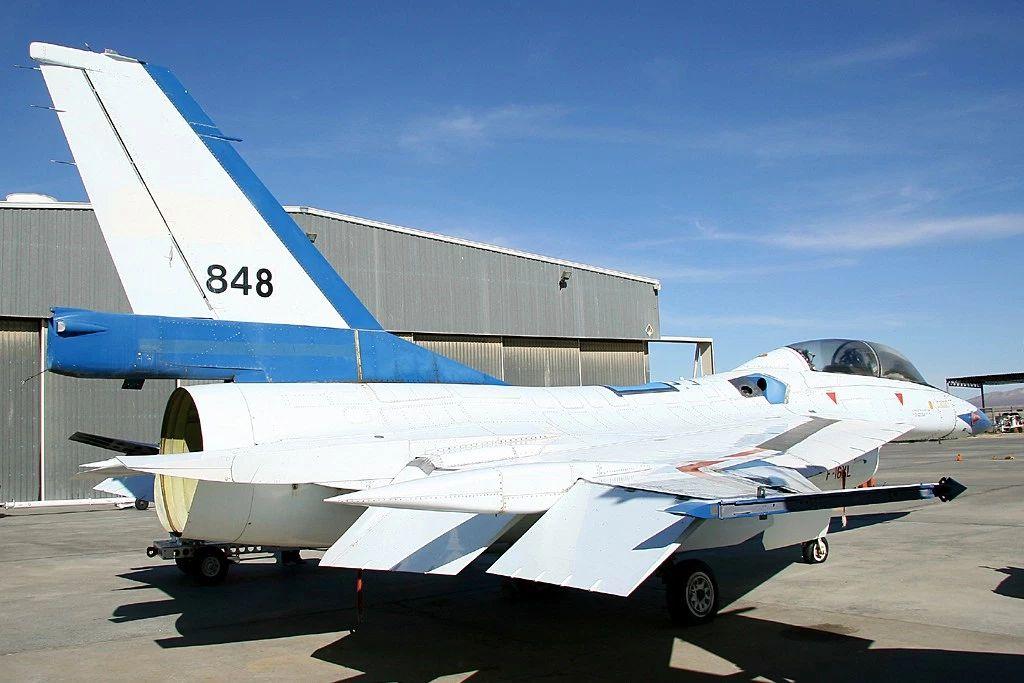 (Image: Mark Forest; F-16XL in the NASA Dryden boneyard)
(Image: Mark Forest; F-16XL in the NASA Dryden boneyard)
On the north side of Edwards Air Force Base in California, immediately north-west of the world’s largest compass rose, lies a small aircraft graveyard where the stripped out hulks of past research projects quietly await their fate. Parked on a disused ramp near the buildings of their former operator (the NASA Dryden Flight Research Center), various retired types have occupied the boneyard over the years. Though its location has shifted from outside the maintenance hangars to the north side of the NASA complex, a handful of airframes remain constant. Today, those mainly include a cluster of early production F-18 fighters and one of only two highly modified General Dynamics F-16XL aeronautical research aircraft.
(Author’s note: NASA Dryden was redesignated the Armstrong Flight Research Center in 2004 in honour of Neil Armstrong, the first human to walk on the Moon. We’ll refer to it by its old name in this article, since most of the boneyard occupants were retired – or flew – under its previous designation.)
 (Image: Google Earth; F-16XL, four F-18As and one YF-18B)
(Image: Google Earth; F-16XL, four F-18As and one YF-18B)
Originally known as the National Advisory Committee for Aeronautics Muroc Flight Test Unit, Edwards’ Dryden Center has gone by a variety of names over the years, including the High-Speed Flight Research Station in the 1940s and the High-Speed Flight Station in the ’50s. Throughout its tenure as NASA’s foremost aeronautical research facility, Dryden has operated some of the world’s most innovative aircraft, from the rocket-powered North American X-15 to the unmanned hypersonic X-43 and many more.
 (Image: Mark Forest; F-16XL research aircraft, coded 848)
(Image: Mark Forest; F-16XL research aircraft, coded 848)
Some of its most famous planes are now proudly displayed at the Flight Test Center’s airpark. These include the LASRE testbed – an SR-71 Blackbird used to determine the aerodynamic performance of a lifting body design combined with a linear aerospike engine – and NASA’s highly modified McDonnell Douglas NF-15B Eagle technology demonstrator/research aircraft. The latter was itself stored in the NASA Dryden boneyard for a period before being restored for static display. Elsewhere, another long-term Dryden resident – an elderly B-52B known as ‘Balls 8’, which was used as a drop test aircraft – was retired in 2004 and displayed at the North Gate of Edwards AFB.
 (Image: Mark Forest; F-18As Nos. 847 and 851)
(Image: Mark Forest; F-18As Nos. 847 and 851)
Most of the retired airframes in the NASA Dryden boneyard are early F/A-18As from the space agency’s mission support aircraft fleet. These white and blue-painted jets are used as chase planes for other research projects, as well as photo and video platforms and, occasionally, research aircraft in their own right. One notable example is NASA’s workhorse F-18 No. 853, which was the subject of an extensive article by Wired reporter Jason Paur and is still in service today.
 (Image: Mark Forest; a stored F/A-18A)
(Image: Mark Forest; a stored F/A-18A)
But unlike their former stablemate 853, these withdrawn airframes will never fly again. Among those pictured are F-18As 847 and 851 (serial numbers 161520 and 161705 respectively). Alongside is the spares-recovered shell of another old F-18 known as Ironbird/SRA, which was used for full-scale “hardware-in-the-loop” simulations. Also present is an ex-US Navy machine, serial number 162414 (the grey F-18A) and a two-seat YF-18B pre-production trainer (160781). According to EuroDemobbed, all of these aircraft have been stored in the NASA Dryden boneyard since at least 2010.
 (Image: Mark Forest; stored F-18A (serial number 161251) known as Ironbird)
(Image: Mark Forest; stored F-18A (serial number 161251) known as Ironbird)
Most notable among the motley line-up is the second of only two F-16XL aeronautical research aircraft ever produced, developed from the venerable General Dynamics F-16 Fighting Falcon. The highly modified jet, coded 848 (serial number 75-0747), first flew as a technology demonstrator in 1982 sporting a cranked-arrow delta wing and extended fuselage that distinguished it from production-standard ‘Vipers’.
 (Image: Mark Forest; the highly modified F-16XL No. 848)
(Image: Mark Forest; the highly modified F-16XL No. 848)
Both aircraft took part in the Enhanced Tactical Fighter (ETF) competition to replace the F-111, but lost to the mighty F-15E Strike Eagle. They were turned over to NASA in 1988 and used in a series of tests including supersonic laminar flow and sonic boom research. Both aircraft were again placed into stored in 1999 and, despite a proposal to reactivate the first F-16XL, they were retired permanently in 2009. The first F-16XL (75-0749) is now displayed at the Air Force Test Center museum, also located within the Edwards AFB complex. Its twin-seat counterpart, No. 848, however, remains in the boneyard.
 (Image: Google Earth)
(Image: Google Earth)
Despite their forlorn appearance, the dry climate should help minimise corrosion of the stored airframes in the NASA Dryden boneyard, hopefully improving their chances of eventual preservation within the Edwards AFB complex or elsewhere. One notable ex-Dryden airframe to find a new home is F-18 High Alpha Research Vehicle (HARV), which is now displayed at the Virginia Air and Space Center. Hopefully others will follow.
Related: The Abandoned B-52 Bombers South of Edwards Air Force Base
The post Historic Research Aircraft in the NASA Dryden Boneyard appeared first on Urban Ghosts Media.